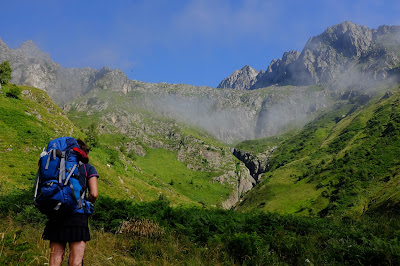Another end to end hike.
We have always wanted to visit the Alps but never really decided where as there does seem to be quite a lot of them. Cicerone's "Trekking in the Alps" alone lists "20 classic routes" all competing for our attention, but there is nothing quite like starting at the sea and ending at the sea as the Pyrenean Haute Route does. So in what seems like a good idea in front of the fire on a cold Dartmoor evening tickets to Trieste are booked and we begin pouring over maps and kit lists in excited anticipation.
So its coming to the end of April, much planning, route worrying and kit selecting has been going on, most of which is totally unnecessary but still an integral part of preparing for one of our hikes. To make it "official" we announced to the world, or at least the Via Alpina Facebook page that we would be starting in June.........
So its coming to the end of April, much planning, route worrying and kit selecting has been going on, most of which is totally unnecessary but still an integral part of preparing for one of our hikes. To make it "official" we announced to the world, or at least the Via Alpina Facebook page that we would be starting in June.........
Hi, we are Nick and Jo Mandeville. We live and work in the Dartmoor National Park in Devon UK. This year we start walking the Via-Alpina from Trieste on the 24th of June hoping to reach Monaco in early October. We have hiked, climbed, camped and bivouacked throughout Dartmoor, Snowdonia, Cumbria, Scotland and the Pyrenees. At a time of great change politically and environmentally we hope to discover an Alps that is inclusive and that inspires particularly the young who once captivated by mountains and wild places are sure to be their future guardians. If you see us stumbling along the trail please come and say Hi.
We aim to follow the "Red Trail" from Trieste as far as its intersection with the "Green Trail" (Alpine Pass Route) which we aim to take through Switzerland before meeting up with the "Tour Du Mont Blanc". At some point on the "TMB" we will break off to join the "GR5" which will form the basis of our route down to Monaco.
Along the way if the weather is kind, we have the time and a little extra in our legs we will try and summit Triglav, Buet and Viso.............its a rough plan anyway!
 |
| Via Alpina Kit. So that is it we are off, if you would like to catch up and see what happens next look us up on Instagram. |
We made it!!!!!.................
On the morning of Monday 25 September, day 94, we hiked the final one and a half hours from our last bivy to the beach at Menton bringing to an end a great adventure. Discovering Slovenia, Italy, Austria, Germany, Lichtenstein, Switzerland and France. Bears, Wolves, Boars, Squirrels, great birds of prey, salamanders, snakes and the most wonderful flowers. Sunshine to nearly 40c, blizzards and high bivys down to -10c.
Lots of pain and huge amounts of pleasure, we reveled in glorious landscapes and met some amazing people.................just for now we will let it sink in!
Read the full story here
Read the full story here





















































